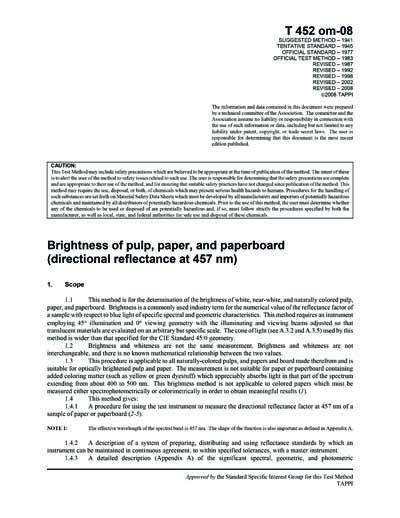Historical
TAPPI T 452 om-08
Brightness of pulp, paper and paperboard (directional reflectance at 457 nm)
Staples launches unified paper brightness standard using TAPPI scale (10/04/04) This method is for the determination of the brightness of white, near-white, and naturally colored pulp, paper, and paperboard. Brightness is a commonly used industry term for the numerical value of the reflectance factor of a sample with respect to blue light of specific spectral and geometric characteristics. This method requires an instrument employing 45° illumination and 0° viewing geometry with the illuminating and viewing beams adjusted so that translucent materials are evaluated on an arbitrary but specific scale. The cone of light (see A.3.2 and A.3.5) used by this method is wider than that specified for the CIE Standard 45/0 geometry. This procedure is applicable to all naturally-colored pulps, and papers and board made therefrom. The measurement is not suitable for paper or paperboard containing added coloring matter (such as yellow or green dyestuff) which appreciably absorbs light in that part of the spectrum extending from about 400 to 500 nm. This brightness method is not applicable to colored papers which must be measured either spectrophotometrically or colorimetrically in order to obtain meaningful results (1). This method gives: A procedure for using the test instrument to measure the directional reflectance factor at 457 nm of a sample of paper or paperboard (2-5). NOTE 1: The effective wavelength of the spectral band is 457 nm. The shape of the function is also important and is defined in Appendix A. A description of a system of preparing, distributing and using reflectance standards by which an instrument can be maintained in continuous agreement, to within specified tolerances, with a master instrument. A detailed description (Appendix A) of the significant spectral, geometric, and photometric characteristics of a master instrument, with a statement of the tolerances which must be met in its construction and maintained during its use. A procedure described in Appendix C for separating the fluorescent component of brightness from the non-fluorescent component of brightness and measuring it quantitatively.
Content Provider
Technical Association of the Pulp and Paper Industry [tappi]






